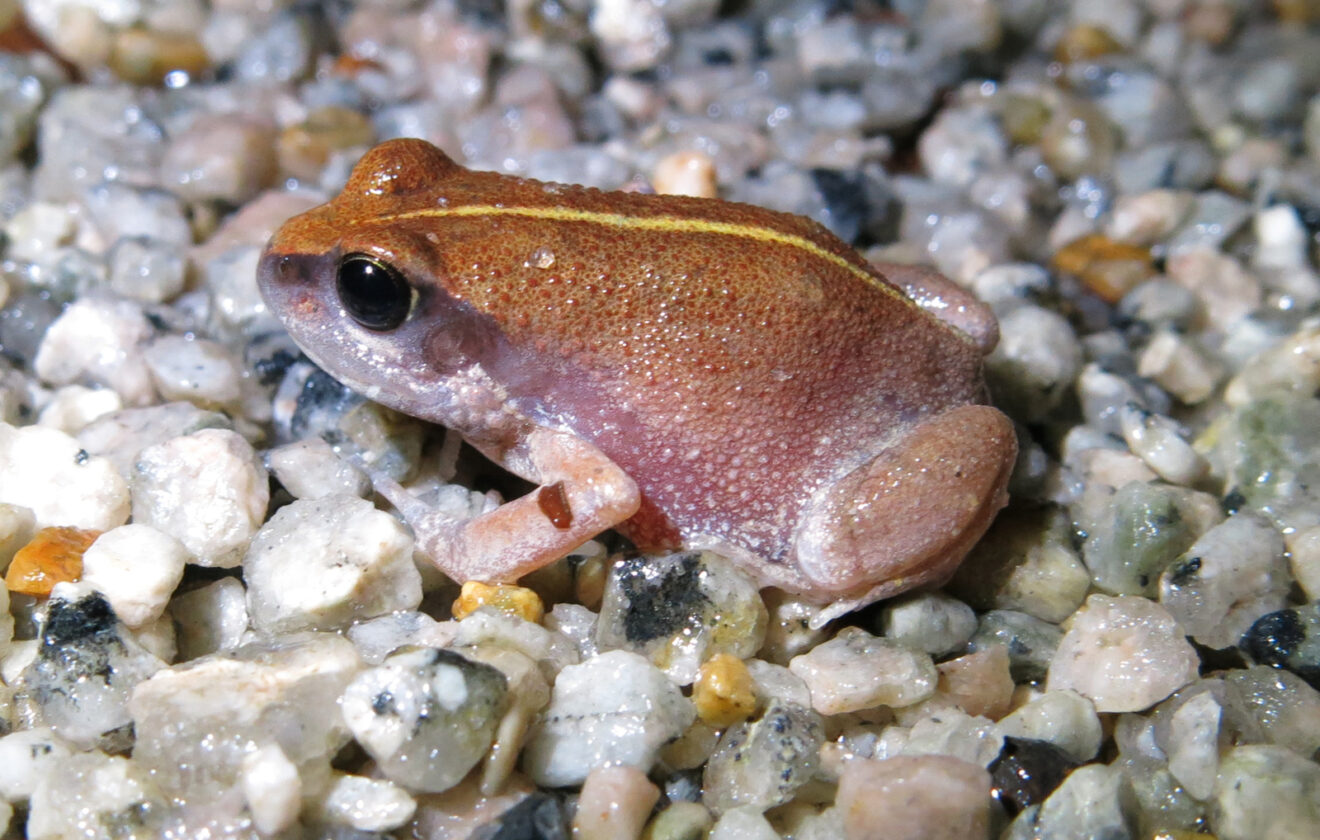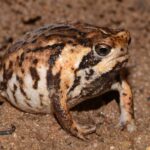- The Secretive Arthroleptis xenochirus: A Journey into the Life of an Elusive Forest Frog
- Introduction: A Hidden Voice in the Forest Floor
- Taxonomy and Classification: Placing Arthroleptis xenochirus on Nature's Tree
- Natural Habitat: Beneath the Canopy of an Ancient Forest
- Physical Characteristics: Clandestine Masters of Camouflage
- Behavior and Life Cycle: Life Away from the Water's Edge
- Ecological Role: Small Yet Indispensable
- Threats and Conservation Status: Protecting the Secretive Squeaker
- Cultural and Scientific Significance: Unveiling Nature's Mysteries
- Conclusion: The Fragile Gift of Amphibian Diversity
The Secretive Arthroleptis xenochirus: A Journey into the Life of an Elusive Forest Frog#
Introduction: A Hidden Voice in the Forest Floor#
Deep in the shaded embrace of Central Africa’s lush forests dwells a creature few have ever glimpsed but whose melodious voice resonates quietly through the leaf litter, mist, and shadow—it is the Arthroleptis xenochirus. Known colloquially as the “Strange-footed Screeching Frog,” these diminutive and unobtrusive amphibians captivate herpetologists and nature enthusiasts alike, offering insights into the fragile ecosystems they inhabit. Scientifically classified within the family Arthroleptidae, Arthroleptis xenochirus is a testament to nature’s enduring resilience and remarkable evolutionary adaptability.
What makes Arthroleptis xenochirus truly fascinating is its unique reproductive strategy—it bypasses the aquatic tadpole stage completely, developing fully formed froglets directly within terrestrial eggs. A frog that has never been a tadpole? Yes, indeed—a curious adaptation for its life among leaf litter and dense vegetation, allowing it to thrive away from permanent water sources. It is in these unusual biological traits and elusive behaviors that our captivating journey with Arthroleptis xenochirus begins.
Taxonomy and Classification: Placing Arthroleptis xenochirus on Nature’s Tree#
Understanding Arthroleptis xenochirus requires placing this remarkable frog correctly within Earth’s vast biological tapestry. The species Arthroleptis xenochirus belongs to the family Arthroleptidae, commonly referred to as “Squeakers” or “Screeching Frogs,” known for their particularly shrill, bird-like vocalizations. Within the genus Arthroleptis, numerous species share similar habitats and characteristics; however, the xenochirus species stands out due to its distinctive foot morphology and terrestrial reproductive modes.
The genus Arthroleptis is characterized by small body sizes, robust terrestrial habits, and direct development strategies. Arthroleptis xenochirus was first described scientifically in the early 20th century and continues to intrigue researchers due to its cryptic behaviors and limited distribution within dense forest ecosystems.
Natural Habitat: Beneath the Canopy of an Ancient Forest#
Arthroleptis xenochirus resides primarily within the dense primary and secondary forests of Central Africa, notably in areas spanning Cameroon, Gabon, Equatorial Guinea, Republic of the Congo, and parts of Central African Republic. These amphibians favor the moist, leaf-littered forest floors—hidden worlds packed tight beneath towering trees and festooned vines. The humid, nutrient-rich ground, carpeted by millennia of decomposing vegetation, serves as their preferred habitat. Within this leaf litter, they find both shelter and an abundance of prey.
The forest floors provide ideal micro-environments, maintaining consistent humidity and temperature levels crucial for their survival. Amidst the perpetual shade, soft chirps and calls echo quietly throughout the undergrowth. Arthroleptis xenochirus chooses habitats far away from permanent water sources—an evolutionary marvel facilitated by their adaptation to terrestrial egg-laying, eliminating the necessity for aquatic tadpole phases.
Physical Characteristics: Clandestine Masters of Camouflage#
Ranging between approximately 20 to 30 millimeters in adults, Arthroleptis xenochirus are notably small frogs, but their diminutive size belies a sophisticated evolutionary harmony with their environment. Their skin displays rich, mottled patterns of brown, olive, and grey—every hue carefully selected by natural forces for ideal camouflage among decomposing leaves and moist soil.
The common name “Strange-footed Screeching Frog” offers a clue to one of its most distinguishing attributes—the toe tips. Unlike other Arthroleptis species, their toes exhibit slightly broader pads and distinctively shaped toes, adaptations hinting at an evolutionary divergence related to the unusual ecological niches these frogs occupy. These specialized feet grant the frogs efficient propulsion across loose soil and organic debris, ensuring minimal disturbance as they navigate the complex forest floor.
Moreover, their eggs—comparatively large, gelatinous, and clumped carefully amongst foliage—are equally camouflaged, offering protection from predators and harsh environmental conditions, subtly hidden from view.
Behavior and Life Cycle: Life Away from the Water’s Edge#
Silent Hunters of the Leaf Litter#
In the shelter of the humid forest understory, Arthroleptis xenochirus employs a predatory strategy suited specifically to its cryptic lifestyle. Primarily insectivores, they skillfully target small insects, spiders, mites, and various abundant invertebrates thriving within leaf litter. Predation events unfold rapidly and silently; a precise dart of the tongue efficiently captures prey before the frog quietly retreats into the cover, leaving no trace but a trembling leaf.
Unique Breeding and Direct Development#
Perhaps most astonishing of their myriad adaptations is their capacity for direct development, an evolutionary solution that discards the traditional amphibian life stages entirely. Rather than laying eggs in water, Arthroleptis xenochirus carefully deposits clusters of terrestrial eggs beneath moist leaves, logs, and organic debris. Inside these protective habitats, development transpires unseen by most—the eggs bypassing the aquatic tadpole phase entirely, instead hatching miniature versions of adult frogs, fully equipped to begin life immediately.
This strategy confers immeasurable ecological advantage, removing reliance on ephemeral water bodies, and enabling them to endure within forest habitats where permanent water is scarce. With direct development facilitating successful reproduction amidst fluctuating environmental conditions, Arthroleptis xenochirus exemplifies amphibian adaptability in challenging ecological scenarios.
Ecological Role: Small Yet Indispensable#
Though elusive and diminutive, Arthroleptis xenochirus holds its own critical place within the forest ecosystem. As voracious insectivorous predators, they balance insect populations, thereby maintaining ecological harmony. Furthermore, as prey, they represent a crucial component of the food web for other forest-dwelling predators—snakes, birds, larger amphibian species, and even small mammals.
Moreover, their sensitivity makes them excellent ecological indicators; fluctuations in their populations may signal broader environmental changes, alerting conservationists to habitat degradation or climatic shifts—services provided freely and quietly, but invaluable nonetheless.
Threats and Conservation Status: Protecting the Secretive Squeaker#
Despite their secretive lifestyles, Arthroleptis xenochirus are vulnerable to habitat loss from logging, deforestation, agriculture, and expanding human settlements. As ecological specialization can increase vulnerability, loss or degradation of their forest floor habitats could rapidly threaten their survival. Climate change, too, poses potential threats through altering rainfall patterns and increasing temperatures, potentially disrupting the delicate humidity balance required for their direct-developing eggs.
Currently, Arthroleptis xenochirus is classified by the IUCN Red List as Least Concern due to their relatively large distribution range and adaptability, but vigilance and continued research are essential. Localized threats could rapidly alter their conservation status, underscoring the urgency of proactive habitat protection and environmental stewardship.
Cultural and Scientific Significance: Unveiling Nature’s Mysteries#
Though not widely recognized culturally, the distinctive reproductive adaptations and ecological roles of Arthroleptis xenochirus are profoundly meaningful to scientists. Their unique patterns of terrestrial development contribute invaluable understanding to evolutionary biology, amphibian adaptation studies, and conservation strategies in tropical ecosystems.
Additionally, their populations act as ecological sentinels indicating forest ecosystem health. Monitoring efforts involving this and related species act as essential environmental barometers, providing early warning signals crucial in forest conservation practices.
Conclusion: The Fragile Gift of Amphibian Diversity#
Arthroleptis xenochirus may be small, cryptic, and rarely encountered by humans, but its significance reverberates quietly through healthy forest ecosystems. Understanding species like the Strange-footed Screeching Frog enriches our comprehension of life’s vast diversity and our responsibilities toward environmental stewardship.
We invite every nature enthusiast, student, activist, and curious wanderer to support conservation initiatives and continue exploring the fascinating world of amphibians. Protecting the delicate habitats of Arthroleptis xenochirus ensures both the survival of this tiny vocal performer and the enduring health of the irreplaceable Central African forests they call home.














